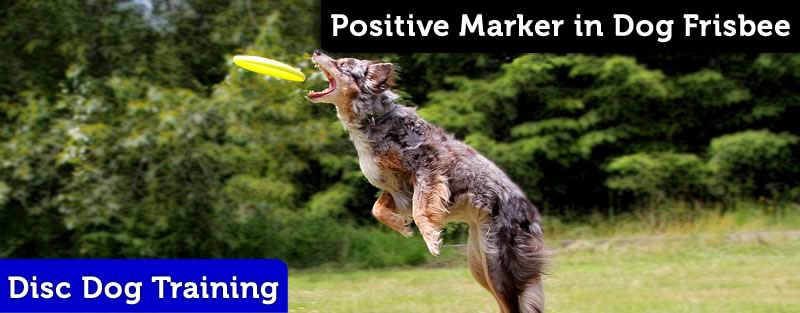
The Importance of Using a Positive Marker in Dog Frisbee
Because Disc dog freestyle is a complex game made of many behaviors: biting, dropping, chasing, catching, retrieving, establishing position, it is very important that our dogs have a clear understanding of their job.
A positive marker “Yes!” can pinpoint the moment that the dog has performed a correct behavior, and when we attach that positive mark to a good reward, such as another disc, the dog not only knows what behavior was expected, but is also much more likely to do the behavior again.
Clear communication and reward history will help your dog understand what is asked of him and increase his desire to perform those behaviors.
Let’s look at how a well timed positive marker and consequent reinforcement help the game of disc.
Dropping a disc
Not many things are more frustrating than trying to get a dog to drop a disc at a distance when the dog does not want to drop. Trying to solve this with pressure can cause problems for a team. Solving this with a positive marker and a reward is simple and fast and only strengthens the bond between dog and handler.
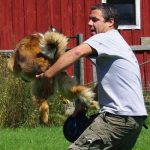
If we want our dog to drop, we simply ask for the behavior and wait. We ask once then do nothing until the dog drops. While the dog is dropping, we give the positive mark, “Yes!” and immediately deliver a roller, throw, or ask for a bite. That’s it. Simple, right?
When we work like this, the dog hears “Drop!” and connects the performance of the behavior to the reward. Dropping the disc makes that other throw or bite happen. When the dog believes that compliance with the request to Drop creates the opportunity for fun and exciting play, he will do so quickly and enthusiastically.
When teaching this it takes a bit of patience and an understanding that the dog will not comply immediately on the first few tries, but the time between the request of “Drop!” and the act of dropping. So if the first one takes 30 seconds, the second will take 20. The third, 10 and so on.
In no time at all, your dog will be dropping at any moment you desire.
Precision Reinforcement
Using a Positive MarkerA Positive Marker is a signal that is used to communicate the exact instant that a behavior is correct and that predicts a positive consequence. A click of the clicker is a Positive... More in disc play allows the handler to hone in on and reinforce very specific behaviors in a precise manner. We can focus in on and work a Drop. We can highlight and pinpoint the Bite, the Leap, a Wait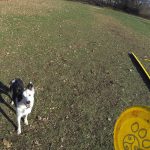 Waiting on cue and situationally is extremely important for disc dog freestyle training. The competition field might not see too much waiting going on as everything is supposed to be happening in flow,... More or whatever we want and can then deliver consequent reinforcement. Being able to isolate the moment that our dog has a solid bite, a well timed drop or a big leap and following that moment up with consequent reinforcement is the key to developing and enhancing those skills and to getting them to happen again.
Waiting on cue and situationally is extremely important for disc dog freestyle training. The competition field might not see too much waiting going on as everything is supposed to be happening in flow,... More or whatever we want and can then deliver consequent reinforcement. Being able to isolate the moment that our dog has a solid bite, a well timed drop or a big leap and following that moment up with consequent reinforcement is the key to developing and enhancing those skills and to getting them to happen again.
Precision marking and variable reinforcement can be leveraged to increase the strength of any behavior.
When we want to reinforce the Catch, we just keep relatively quiet and not too excited (in both our emotional state and the state of the game) until the Catch happens. The Catch is marked and reinforced with excitement and a heightened energy level of play. It’s simple really, the dog learns that Catching a disc actually makes the game turn on; their behavior affects the consequence of the game. That is the definition of Operant, and once our dogs understand that we’re off the the races.
What usually happens with dogs is that the negative behaviors are really highlighted and attention is drawn to them, from “Oops, you screwed up.” to “DUDE!” to “AAARRRGGHHH!!!!” The animation of the handler increases as the dog is failing or struggling with the task at hand, providing reinforcement that either cancels itself out or works against us. This kind of reinforcement is not what we need to be successful in a complex game dependent upon long chains of behaviors.
The seemingly inconsequent and, especially, the seemingly negative reinforcement of so much of the game is hard on dogs. They get confused. They stop trying.
Keeping the Flow
When we use a Positive Marker within the confines of Positive Training, capturing and shaping behavior through successive approximation and clear communication we are able to build a flow in the game that becomes a valuable motivator. “Through… yes! – Go around… yes!” and here’s the throw… “Yes!” on the catch – “Here!… dog turns to handler…yes!” – “Through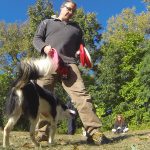 A Through is a set up move where the dog runs between the handler’s legs. The dog can move from front to back or side to side and can even weave. A Through... More, yes!”
A Through is a set up move where the dog runs between the handler’s legs. The dog can move from front to back or side to side and can even weave. A Through... More, yes!”
Everything starts to work. The dog is given a steady stream of positive reinforcement and given the proper feedback via the positive marker to know they’re on track.
If something goes wrong,”Through…” dog does not go through? Nothing happens. Wait a second or three. “Through… yes!” reward with a bite or throw and get the game moving again.
Pretty soon we’ll have a Freight Train of success to contend with and who couldn’t use a little of that?





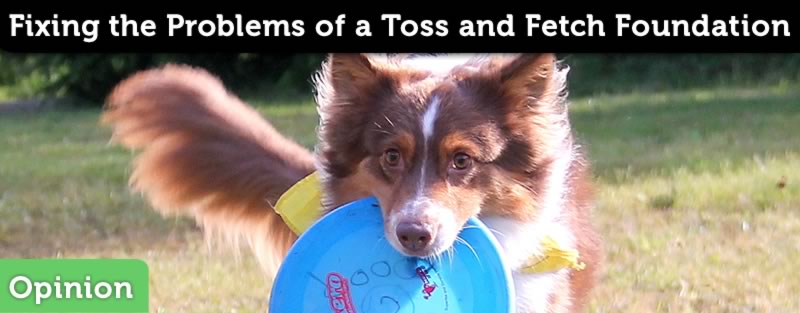
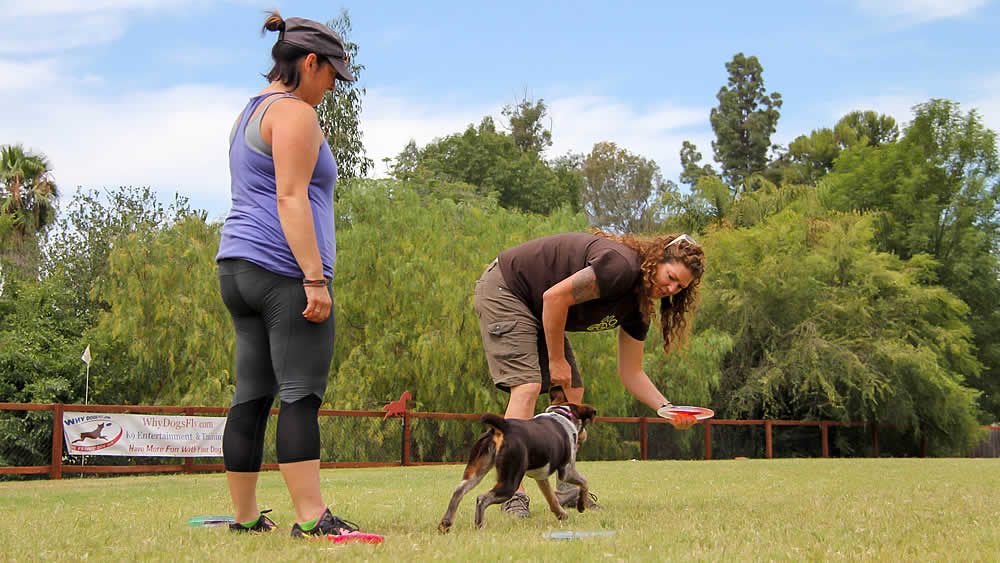
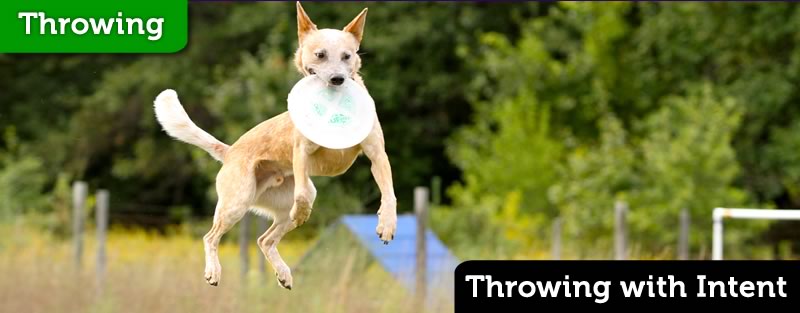
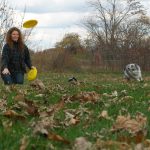
Ron, I’m wondering what I should do if when I’m teaching my dog interest in the frisbee. Do all other rules go by wayside? For example, my dog, Kaya, will grab the frisbee. I reward with a tug, let her win, and sometimes she will start going away from me and drop the frisbee.
Should I…
a) Ignore her and stop playing
b) try to call her back before she drops the disc
c) go and get the disc while it is still in her mouth and try to get her interested
d) none of the above
These get me stumped because they all can contradict learning. If I do choice “a”, then I will be stopping when she’s bored/uninterested.
If I do choice “b”, then that defeats the purpose of the bitework retrieve.
If I do choice “c”, then that will teach her that going away from me gets her to play more and retrieving doesn’t matter.
Should I reject a previous “rule” of biteowork because I’m in the beginning stages of getting my dog interested in the disc. Or should I be doing something else?
Thanks
Zachary
E) Predict and Cue the Drop
Then reward with a bite on the disc you are holding.
F) Regrab the disc and tug again… repeat…
Stump Removal
a – Packing it in. That is the lesson, period. It is a problem in that the game ends and no more teaching can be done. A valuable tool, but probably not in this situation.
b – not only will it defeat the purpose of bitework, it will not work. It’s lumping a ton of behaviors together and hoping they will all work. It’s great if it works, but if it doesn’t, you need something else.
c – You could look at it that way, or you could look at it as “It’s only cool when we’re playing together,” it’s a good tactic. This is similar to the regrab I mentioned, but the regrab is preemptive. Doing it the way you outlined in c allows the dog to run, and you running with her could be quite reinforcing, which plays right into your point. I might do something like this on occasion, but making it a pattern would surely be a problem.
The Second Rule of Bitework: Drop it when I ask must be taught before it can be put into effect.
Sounds like you’re doing great, Zachary.
Peace~
Well, last night I decided to use twisted and knotted rags to see if she would like them better. This morning I tried bitework with them and it took almost no effort to get her interested. (Yes!) She tugs, retrieves, and drops on cue. Do you think after one or two weeks of bitework with the rags that my dog will switch to the frisbees easily? Or should I constantly be switching between the types of toys?
Thanks again,
Zachary